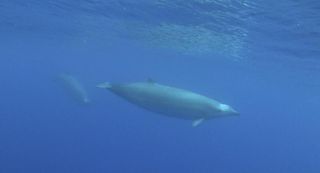
For the first time ever, scientists have captured video of one of the ocean's most mysterious creatures swimming underwater.
The video reveals the True's beaked whale, a deep-diving cetacean whose sightings are so rare that many researchers who study the creatures go their whole lives without spotting one.
The video, along with new information on the beaked whale's physical color and distribution in the world's oceans, was published today (March 7) in the journal PeerJ.
The True's beaked whale is a member of the family Ziphiidae. Though there are 22 types of beaked whale, they are some of the least studied members of the Ziphiidae family. The True's beaked whale, in particular, is mysterious because it lives far offshore, and may spend 92 percent of its time underwater, according to a statement from the journal. [See the Video of the Rare Whale]
"Ziphiids dive to depth for long periods of time, with only short breathing intervals at the sea surface," the researchers wrote in the article.
Some of these dives can reach depths of about 10,000 feet (3,000 meters) and last 2 hours, according to the statement. Unlike some of the more camera-friendly cetaceans, True's beaked whales stick to small groups, don't perform the flips and twists typical of dolphins, and don't seem to pursue boats as some other cetaceans do. What's more, these whales have some features that can make it tricky to distinguish them from other beaked whales. Combined, these features make it very difficult for scientists to learn more about the mysterious creatures, the researchers wrote in the study.

To do so, the researchers pooled their resources. By combining data from whale-watching expeditions, educational organizations and scientists, the team determined that the Azores (in Portugal) and the Canary Islands (in Spain) may actually be common spots for these whales to congregate. That may be because around these strings of islands, the ocean depth drops off steeply, creating the deep waters ideal for the True's beaked whale relatively near the shoreline. Past research found True's beaked whales in the North Atlantic Ocean and the Southern Hemisphere, but nowhere in between, so the new study extends the southern limit of the animals in the North Atlantic.
Sign up for the Live Science daily newsletter now
Get the world’s most fascinating discoveries delivered straight to your inbox.
In addition to determining the hotspot for the beaked whales and capturing the underwater video of the elusive animals, the new study identified unique color patterns on the True's beaked whale's body that could help distinguish it from other species.
The new findings could aid conservation efforts by making it easier to identify whales that have been part of mass strandings or that have beached themselves with plastic in their stomachs, according to the statement.
Originally published on Live Science.

Tia is the managing editor and was previously a senior writer for Live Science. Her work has appeared in Scientific American, Wired.com and other outlets. She holds a master's degree in bioengineering from the University of Washington, a graduate certificate in science writing from UC Santa Cruz and a bachelor's degree in mechanical engineering from the University of Texas at Austin. Tia was part of a team at the Milwaukee Journal Sentinel that published the Empty Cradles series on preterm births, which won multiple awards, including the 2012 Casey Medal for Meritorious Journalism.
